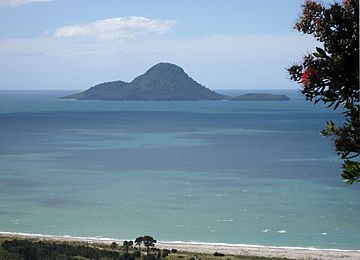Moutohora Island facts for kids
Quick facts for kids Moutohora Island |
|
|---|---|
| Moutohorā (Māori) | |

Moutohora Island seen from the south.
|
|
| Highest point | |
| Elevation | 353 m (1,158 ft) |
| Prominence | 353 m (1,158 ft) |
| Geography | |
| Location | Bay of Plenty, North Island, New Zealand |
| Geology | |
| Mountain type | Complex volcano |
| Last eruption | Pleistocene |
Moutohora Island (also known as Whale Island) is a small, uninhabited island off the coast of New Zealand's North Island. It's about 9 kilometers (5.6 miles) north of Whakatāne in the Bay of Plenty. The island is 1.43 square kilometers (0.55 square miles) in size.
Moutohora is what's left of an old complex volcano. Over time, the volcano has worn away, leaving two peaks. Even today, the area is still volcanically active. You can find hot springs on the island in places like Sulphur Valley, McEwans Bay, and Sulphur Bay.
Contents
What's in a Name?
The Māori name for the island is Moutohorā. This name comes from Motutohorā, which means "Whale Island" or "Captured Whale." The word Tohorā is the Māori name for the southern right whale. Sometimes, people use the spelling "Motuhora" or "Moutohorā" with a macron (a line over the 'a'). However, the island's official name doesn't include the macron.
Island History
Moutohora Island has a rich history, with signs of both Māori and European life.
- Early Māori Life: Many years ago, Māori people lived on the island. They built a strong pa (a fortified village) on Pa Hill. There are also signs of old house sites, gardens, and places where they made stone tools. After the early 1800s, Māori no longer lived on the island all the time. However, the Ngāti Awa and Tūhoe tribes still visited. They came to gather seafood, catch muttonbirds, and collect stones for their hāngī (underground ovens).
- European Attempts: In the 1830s, Europeans tried to set up a whaling station on the island. But they didn't catch any whales, so the business failed. Later, in the 1870s, people tried to mine sulphur from the island. They sold it to a factory in Auckland, but the sulphur wasn't very good quality. This effort stopped in 1895.
- Quarrying Rock: From 1915 to 1920, workers quarried rock from the island. They removed about 26,000 tons of rock. This rock was used to help build the harbor wall in Whakatāne.
Amazing Ecology and Wildlife
In 1965, Moutohora was made a wildlife refuge. This means it's a special protected area for animals and plants. The New Zealand government bought the island in 1984.
- Restoring the Island: Before it became a refuge, animals like goats, rats, cats, and rabbits lived on the island. These animals harmed the native plants and animals. After they were removed, a big planting program started. Today, there are 12,000 plants of 45 different types growing there. The island is now covered with native trees like pōhutukawa, māhoe, and kānuka.
- Island Animals: Moutohora is a safe home for many native animals. One important bird is the grey-faced petrel, which has a breeding colony here. Other birds that breed on the island include Sooty shearwaters, little blue penguins, and the threatened New Zealand dotterel. Sometimes, rare birds like the Caspian tern, North Island kaka, and New Zealand falcon visit. You can also find common forest birds, red-crowned parakeets, three types of lizards, and fur seals.
- Marine Life: The waters around Moutohora are full of marine life. You might see different kinds of dolphins, pilot whales, and killer whales. Larger whales, like southern rights and other baleen whales, also pass by during their migrations.
- Bringing Back Birds: In 1999, the local Ngāti Awa tribe and the New Zealand Department of Conservation worked together. They moved 40 North Island saddleback (tīeke) birds from Cuvier Island to Moutohora. This was a special event, as it followed an old Māori story. In the story, two tīeke birds flew with the Mataatua waka (canoe) (a traditional canoe) from Repanga to Whakatāne. The birds briefly rested on Moutohora before returning to Cuvier Island.
Visiting Moutohora Island
Public access to Moutohora Island is limited. Only people with special permits from the Department of Conservation can visit. This helps protect the island's fragile environment. Sometimes, during very dry weather, all visits might be stopped because of fire danger.
The local Māori tribe, Ngāti Awa, and three tour companies from Whakatāne have permission to take visitors to the island. These companies are Prosail / Whale Island Kayaking, Diveworks Charters Whale Island Tours, and Ngāti Awa Tourism.
Moutohora in Popular Culture
- Harry Potter: In the magical world of Harry Potter, Moutohora is home to a professional Quidditch team called the Moutohora Macaws. Their team colors are red, yellow, and blue.
- Video Game: The racing video game Redout features a racing track called "The Volcano" that is set on Moutohora Island.
Images for kids
See also
 In Spanish: Isla Moutohora para niños
In Spanish: Isla Moutohora para niños



